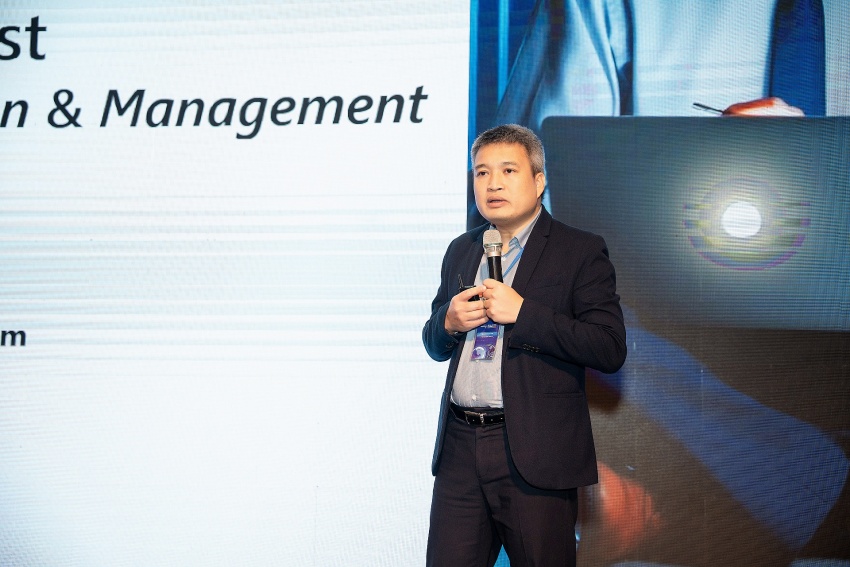Vietnam's cloud transition strategy discussed at summit
At the Data Centre and Cloud Infrastructure Summit held on March 18, Hoang Van Ngoc, director of Viettel IDC, said, "The total value of the global data centre market is expected to reach around $321 billion in 2024."
The scale of the cloud market in Vietnam is currently over $400 million and is forecasted to reach approximately $1 billion by 2025. This represents significant growth potential for top cloud service providers such as VNPT, Viettel, and CMC.
 |
| Le Nhan Tam, CTO of Microsoft Vietnam |
"Mastering the cloud is not just a technology, business, or system problem. It is multi-faceted, involving people, processes, and technology, and ultimately affects the culture of an organisation as a whole," said Le Nhan Tam, CTO of Microsoft Vietnam.
According to Tam, the roadmap for Vietnam's cloud infrastructure transformation will consist of four stages. The first stage is migration, or building the foundation and achieving quick wins, where the focus is on constructing cloud-based computing infrastructure to quickly attain quick-win projects. The second stage is optimising IT costs and enabling new capabilities, where the emphasis shifts to optimising existing infrastructure to run more efficiently, while also gaining new capabilities.
After streamlining processes, the third stage is application modernisation, which involves updating applications and data platforms to fully utilise the new capabilities. In the past, applications were developed using a particular programming language and framework library, but after a few years, these applications may no longer meet performance and IT security or speed requirements.
The fourth stage is digital transformation and business innovation. Once the cloud infrastructure is ready and sufficiently mature, focus shifts to innovation to create competitive business advantages and new business models to save costs.
Experts at the conference discussed the numerous benefits for businesses if they manage the four stages correctly. Hardware savings are evident through reduced expenditures on servers, storage, and networking equipment, as cloud services eliminate the need for extensive on-premises hardware.
Additionally, software savings accrue from avoiding the costs associated with unused third-party software licences. Maintenance costs are significantly reduced due to vendor contract consolidation, freeing up resources for other endeavours. Moreover, there are substantial savings in data centre facility expenses and energy consumption, leading to improved cash flow.
With cloud providers offering higher Service-Level Agreements, uptime is guaranteed at a minimum of 99.9 per cent, ensuring uninterrupted operations. Disaster Recovery as a service is both cost-effective and swift, enabling businesses to recover from disruptions rapidly. Administration efficiency is enhanced through automated management processes and actionable insights derived from cloud analytics.
Furthermore, businesses benefit from reduced cyber risks, as cloud platforms incorporate multi-layered security controls and leverage threat intelligence to mitigate potential threats effectively. Overall, transitioning to cloud infrastructure yields significant cost savings, operational efficiencies, and enhanced security posture for enterprises.
The economic benefits that cloud infrastructure transformation brings are apparent, but how much a business should spend on the cloud and how it can avoid overspending also requires strategy. Experts at the summit emphasised managing cloud costs within an organisation will depend not only on technology but also on three factors: technology, people, and processes.
Firstly, utilising newer, energy-efficient equipment and applying effective energy-saving technologies can lead to cost savings. Secondly, people play a crucial role in cost management by responsibly using cloud resources, not letting the system run when it's not being utilised. Finally, processes, including those governing cloud service usage within organisations, significantly impact cost-management effectiveness.
"Defining a process for the use, management, and allocation of cloud resources also contributes to successful cloud-cost management. At Microsoft, we have individual cost centres for each person. We track how each of us utilises internal resources, all accounted for in our respective cost centres, compelling each individual to manage expenses accordingly. Establishing a framework like FinOps helps businesses find an optimal balance among quality, cost, and time to market," said Tam.
 | Service providers bet on the cloud While venturing further with new investment and products, Vietnamese cloud service providers need smarter approaches to compete with international players. |
 | How cloud technology can help sustainable business growth The world is continuing to embrace data analytics innovation, and digital transformation. We are starting to see the rise of technologies like AI, machine learning, and the Internet of Things. Policy counterparts, industry groups and others are also trying and unblocking hurdles to meet their own sustainability goals, and their climate ambitions. |
 | Cloud and data centre advances on horizon While the amended Law on Telecommunications is expected to bring new opportunities for businesses in cloud computing and data centres in Vietnam from next summer, experts and businesses are still concerned about barriers that may remain. |
What the stars mean:
★ Poor ★ ★ Promising ★★★ Good ★★★★ Very good ★★★★★ Exceptional
Related Contents
Latest News
More News
- Siemens presents sustainable industrial innovations at VIMF 2024 (June 20, 2024 | 15:45)
- Germany supports green technology pilot for Vietnamese businesses (June 18, 2024 | 19:31)
- Nitin Kapoor of AstraZeneca Vietnam appointed MBE (June 18, 2024 | 19:11)
- Hoan My leads healthcare transformation (June 17, 2024 | 08:00)
- Aus4Transport strengthens Vietnam and Australia transport ties (June 14, 2024 | 14:39)
- Empowering Vietnamese businesses to succeed in global business landscape (June 13, 2024 | 10:14)
- Sandoz and Vietnam National Cancer Hospital sign MoU to improve standards of care for oncology patients (June 13, 2024 | 09:48)
- Over 200 enterprises attend Vietnam AutoExpo 2024 (June 13, 2024 | 09:00)
- MPI and VINASME to educate Vietnamese SMEs (June 12, 2024 | 17:48)
- Japfa Vietnam invests VND400 billion to expand animal feed mill (June 11, 2024 | 14:00)


 Tag:
Tag:





















 Mobile Version
Mobile Version